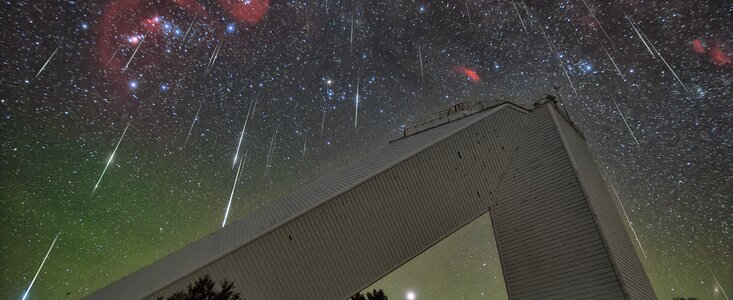Beat the Heat at Kitt Peak National Observatory with New Experiences
Tickets for sale to view the Perseid meteor shower 11–12 August and observe stars and planets with the new Daytime Observing Program
26 July 2024
Kitt Peak National Observatory will host a Perseid meteor shower watch party on 11–12 August, from 7 p.m. to midnight. Stand amongst the world-class telescopes that astronomers use to discover our Universe while fiery pieces of cosmic dust streak across the night sky.
The Perseids are widely regarded as the most consistent and amazing meteor shower to grace our skies each year. The shower is associated with comet Swift-Tuttle and can produce displays of up to 100 ‘shooting stars’ per hour. And what better location to watch the show than from high in the Quinlan mountains on the Tohono O’odham Nation, beneath the clear skies of the Sonoran Desert?
This experience will include a light dinner, after which, weather permitting, there will be guided stargazing, and views of stars, galaxies and more through our Visitor Center 0.5-meter telescope, and also an open area to view the meteor shower with members of our guide team. There is a limited number of picnic benches available. We recommend bringing a comfortable chair to sit in, such as an adjustable lawn chair, or a blanket if you wish to lie down. This year's shower starts during a first-quarter Moon, so there will be fewer meteors visible until the Moon starts to set around 11 p.m. The 11 and 12 August are sure to be memorable nights at Kitt Peak National Observatory.
A new and unique offering is the new Daytime Observing Program which will offer, weather permitting, daytime views of bright objects in deep space and within our Solar System at one of our Visitor Center observatories, and safety-filtered views of the surface of the Sun. The program runs 1–5 p.m. and a light lunch will be provided. A visit to the Nicholas U. Mayall 4-meter telescope is also included. Temperatures are generally 5–10 deg C (10–20 F) cooler at Kitt Peak than at the base of the mountain and in Tucson. Come up to escape the heat!
Book your tickets for the Daytime Observing Program and Perseid Meteor Shower Watch Party here.
More information
NSF NOIRLab (U.S. National Science Foundation National Optical-Infrared Astronomy Research Laboratory), the U.S. center for ground-based optical-infrared astronomy, operates the International Gemini Observatory (a facility of NSF, NRC–Canada, ANID–Chile, MCTIC–Brazil, MINCyT–Argentina, and KASI–Republic of Korea), Kitt Peak National Observatory (KPNO), Cerro Tololo Inter-American Observatory (CTIO), the Community Science and Data Center (CSDC), and Vera C. Rubin Observatory (operated in cooperation with the Department of Energy’s SLAC National Accelerator Laboratory). It is managed by the Association of Universities for Research in Astronomy (AURA) under a cooperative agreement with NSF and is headquartered in Tucson, Arizona. The astronomical community is honored to have the opportunity to conduct astronomical research on I’oligam Du’ag (Kitt Peak) in Arizona, on Maunakea in Hawai‘i, and on Cerro Tololo and Cerro Pachón in Chile. We recognize and acknowledge the very significant cultural role and reverence that these sites have to the Tohono O’odham Nation, to the Native Hawaiian community, and to the local communities in Chile, respectively.
Links
- Purchase tickets
- Images of the Kitt Peak Visitor Center
- Images of Kitt Peak National Observatory
- Site map of Kitt Peak National Observatory
Contacts
Peter McMahon
Kitt Peak Visitor Center Operations Manager
NSF NOIRLab
Email: peter.mcmahon@noirlab.edu
Josie Fenske
Jr. Public Information Officer
NSF NOIRLab
Email: josie.fenske@noirlab.edu


